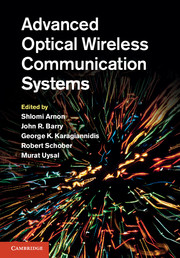Book contents
- Frontmatter
- Contents
- List of contributors
- Part I Outlook
- Part II Optical wireless communication theory
- Part III Unique channels
- 8 Modeling and characterization of ultraviolet scattering communication channels
- 9 Free-space optical communications underwater
- 10 The optical wireless channel
- 11 Hybrid RF/FSO communications
- Part IV Applications
- Index
9 - Free-space optical communications underwater
from Part III - Unique channels
Published online by Cambridge University Press: 05 June 2012
- Frontmatter
- Contents
- List of contributors
- Part I Outlook
- Part II Optical wireless communication theory
- Part III Unique channels
- 8 Modeling and characterization of ultraviolet scattering communication channels
- 9 Free-space optical communications underwater
- 10 The optical wireless channel
- 11 Hybrid RF/FSO communications
- Part IV Applications
- Index
Summary
Wireless optical communications underwater is enjoying a renewed interest from researchers due to the wide advances in laser sources and receivers, digital communications, and signal processing. Underwater free space optics (uFSO) fulfills several niche applications for wireless communications in ocean waters. While RF communications have become ubiquitous in our everyday lives above water, the RF portion of the electromagnetic spectrum exhibits high attenuation in seawater. Acoustics on the other hand have long enjoyed success for detection and communication underwater, given their ability to propagate long distances underwater (> km). However, for high-speed data transfer (> Mbps), acoustics are at a disadvantage, as it is well known that acoustic energy exhibits increasing attenuation with increasing frequency. Supported by enormous growth in the telecommunications industry over the past few decades, optical techniques are garnering serious consideration for underwater communications due to the high data rates they may provide. Additionally, as we will learn, the blue/green portion of the visible spectrum exhibits minimal absorption in seawater. Still, scattering of light by organic and inorganic particulates in ocean water can cause significant spatial and temporal dispersion, which may have a measurable impact on link range and available bandwidth.
This chapter serves as both an introduction to the field of light propagation under-water, as well as a survey of current literature pertaining to uFSO. We begin with a simple examination of a link budget equation. Next, we present an introduction of ocean optics in order to gain an appreciation for the challenges involved with implementing free-space optical links underwater.
Information
- Type
- Chapter
- Information
- Advanced Optical Wireless Communication Systems , pp. 201 - 239Publisher: Cambridge University PressPrint publication year: 2012
Accessibility standard: Unknown
Why this information is here
This section outlines the accessibility features of this content - including support for screen readers, full keyboard navigation and high-contrast display options. This may not be relevant for you.Accessibility Information
- 13
- Cited by
